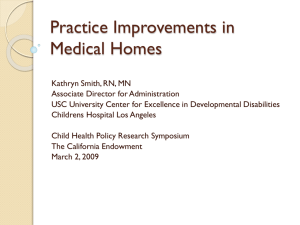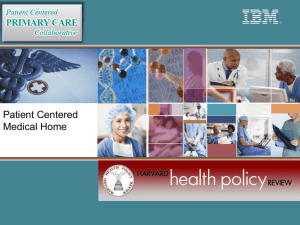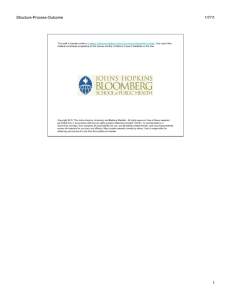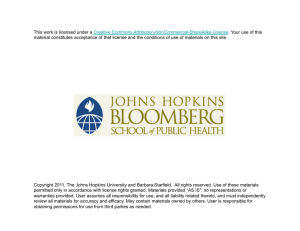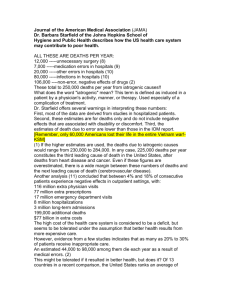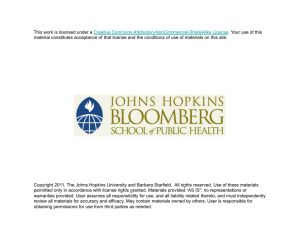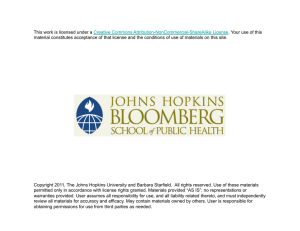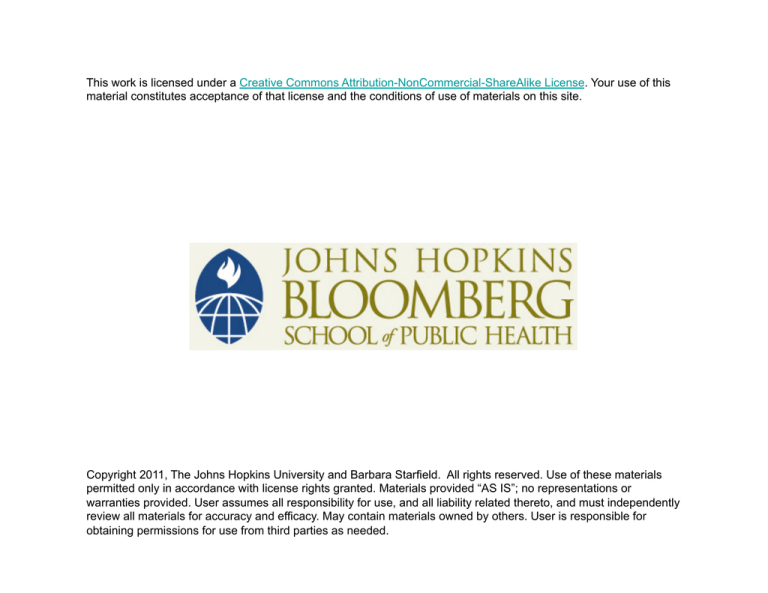
This work is licensed under a Creative Commons Attribution-NonCommercial-ShareAlike License. Your use of this
material constitutes acceptance of that license and the conditions of use of materials on this site.
Copyright 2011, The Johns Hopkins University and Barbara Starfield. All rights reserved. Use of these materials
permitted only in accordance with license rights granted. Materials provided “AS IS”; no representations or
warranties provided. User assumes all responsibility for use, and all liability related thereto, and must independently
review all materials for accuracy and efficacy. May contain materials owned by others. User is responsible for
obtaining permissions for use from third parties as needed.
The Features of Primary Care:
First Contact, Person-focused
over Time, Comprehensiveness,
and Coordination
Barbara Starfield, MD, MPH
Primary Care Course
(Based on Cape Town, South Africa, 2007;
and Barcelona, Spain, 2009)
Primary care is characterized
by four essential functions. This
presentation summarizes
evidence for the utility of each
of these functions.
Starfield 02/11
PCB 7460
First Contact
Starfield 08/09
FC 7180
The Health Services System
CAPACITY
Provision
of care
PERFORMANCE
Personnel
Facilities and equipment
Range of services
Organization
Management and amenities
Continuity/information systems
Knowledge base
Accessibility
Financing
Population eligible
Governance
Problem recognition
Diagnosis
Management
Reassessment
Community
resources
Cultural and
behavioral
characteristics
People/practitioner interface
Receipt
of care
HEALTH STATUS
(outcome)
Biologic endowment
and prior health
Source: Starfield. Primary Care:
Balancing Health Needs, Services, and
Technology. Oxford U. Press, 1998.
Utilization
Acceptance and satisfaction
Understanding
Participation
Longevity
Comfort
Perceived well-being
Disease
Achievement
Risks
Resilience
Social, political,
economic, and
physical
environments
Starfield 02/09
HS 5064 n
The Health Services System: First Contact Components
Accessibility
CAPACITY
Provision
of
care
PERFORMANCE
Receipt of
care
Utilization
HEALTH STATUS
(outcome)
Source: Starfield. Primary Care: Balancing Health Needs,
Services, and Technology. Oxford U. Press, 1998.
Starfield 1999
HS 5369 n
Accessibility is a structural feature of
services that makes it possible for people to
reach care in time and place.
Access is the ability of people to reach
services when and where they need them.
Use of services is the actual reaching of
services. It should distinguish both the place
and the type of services reached.
Source: Millman. Access to Health Care in America.
National Academy Press, 1993. Provides a different
definition (ability of people to reach services when
and where they need them).
Starfield 08/09
FC 5380
Benefits of First
Contact Care
• Lower costs
• More efficient use of specialists
• Better outcomes of care for primary
care problems
Starfield 03/98
FC 5289
First contact care (in primary
care) is associated with lower
costs and better outcomes.
Sources: Moore et al, N Engl J Med 1979; 300:1359-62. Roos et
al, Inquiry 1979; 16:73-83. Hurley et al, Am J Public Health 1989;
79:843-6. Forrest & Starfield, J Fam Pract 1996; 43:40-8.
Starfield 07/03
FC 6065
First Contact Care and Health Spending
Starfield 08/02
FC 5922 n
Family Physicians, General
Internists, and Pediatricians
A nationally representative study showed that adults
and children with a family physician (rather than a
general internist, pediatrician, or sub-specialist) as
their regular source of care had lower annual cost of
care, made fewer visits, had 25% fewer prescriptions,
and reported less difficulty in accessing care, even
after controlling for case-mix, demographic
characteristics (age, gender, income, race, region, and
self-reported health status). Half of the excess is in
hospital and ER spending; one-fifth is in physician
payments; and one-third is for medications.
Source: Phillips et al, Health Aff 2009;28:567-77.
Starfield 03/09
PC 7103 n
Health Care Expenditures and
Mortality 5 Year Followup:
United States, 1987-92
• Adults (age 25 and older) with a primary
care physician rather than a specialist
as their personal physician
– had 33% lower cost of care
– were 19% less likely to die (after controlling
for age, gender, income, insurance,
smoking, perceived health (SF-36) and 11
major health conditions)
Source: Franks & Fiscella, J Fam Pract 1998; 47:105-9.
Starfield 11/02
WCUS 5435 n
Children who were referred to
an otolaryngologist for
possible T & A – rather than
going directly there – are
more likely to have
• Appropriate indicators for T & A
• Better outcomes at one year
Source: Roos et al, Inquiry 1979; 16:73-83.
Starfield 08/02
FC 5921
Scores for Average Total Primary Care,
Primary Care (Clinical), Primary Health Care
(Systems), and First Contact
Average
total primary
care
Primary
care
(clinical)
Primary
health care
(systems)
First
Contact
BE, FR, GE,
US
0.4
0.1
0.6
0.3
AU, CA, JP,
SW
1.0
0.9
1.1
1.3
DE, FI, NE,
SP, UK
1.6
1.5
1.7
1.8
Starfield 03/09
FC 7107 n
Continuity
Starfield 08/09
CONT 7181
Definitions of Continuity That
Are Amenable to Measurement
• Having the same provider
• Stability of patient-caregiver relationships
• Strong interpersonal relationships
• Educating the patient; communicating the
patient’s needs
• Common management strategy/plan
Starfield 05/01
CONT 5737
Definitions of Continuity NOT
Amenable to Measurement
•
•
•
•
•
•
Orderly, uninterrupted movement of patients
Team approach
Even flow of care
Care that is regularly handed off
Improving communication methods
Too many practitioners (as few providers as
possible)
• Trust (??)
Starfield 05/01
CONT 5736
Continuity =
Uninterrupted Succession
Starfield 05/01
CONT 5730
“Uninterrupted Succession”
Bridging discrete events
Events are part of time.
Starfield 05/01
CONT 5731
The Essence of Continuity
Is Information Flow
• Between events (management)
• Over time (relational)
Source: Starfield. Primary Care: Balancing Health Needs,
Services and Technology. Oxford U. Press, 1998.
Starfield 05/01
CONT 5732 n
Continuity: Issues
Disease versus person focus
Episode of care versus continuum of
care (duration)
Starfield 05/01
CONT 5733 n
Do we need a different term for
each?
1. For measurement purposes
2. For assignment of responsibility
Starfield 05/01
CONT 5734
The common unifying theme between
person-focused and disease-focused
continuity is the structural features of
INFORMATION TRANSFER
The behavioral feature differs in
• use of services: consistency of place over
time (person-focus)
• recognition of information across visits
(illness-focus)
Starfield 08/09
CONT 5738
Measurement of “Continuity”:
Information Transfer
Mechanisms of information transfer:
By person
By records
By computers
By patients
Recognition of information
Starfield 05/01
CONT 5739
Measurement of “Continuity”*:
Management
Same provider (SECON index)
Care coordinator (? primary care)
Common problem lists
*? Coordination
Starfield 05/01
CONT 5740
Measurement of “Continuity”*:
Relational
Affiliation: PCAT measure of extent of relationship
Provider-patient relationship: PCAT measure of
interpersonal relationships
Duration
Consistency: UPC, COC
*? Longitudinality
Starfield 05/01
CONT 5741
Conclusion
There are two types of “continuity”:
• Relational (person-focused), longitudinal
• Management (disease-focused), coordinating
The common underlying theme is information
transfer.
Primary care requires relational continuity, i.e.,
longitudinality. Both primary care and specialty
care require management continuity, i.e.,
coordination.
Starfield 05/01
CONT 5744
Longitudinality
Starfield 08/09
LONG 7182
IOM Formulation:
“Sustained partnership in which the
patient is treated as a whole person
whose values and performance are
taken into account”
Starfield 04/97
LONG 5117
The Health Services System: Longitudinality
Eligible population
CAPACITY
Provision
of
care
PERFORMANCE
People/practitioner interface
Receipt of
care
Utilization
HEALTH STATUS
(Outcome)
Source: Starfield. Primary Care:
Balancing Health Needs, Services, and
Technology. Oxford U. Press, 1998.
Starfield 1999
HS 5370 n
Benefits of Longitudinality (Person-centered over Time),
Based on Evidence from the Literature
Better problem/needs recognition
More accurate/earlier diagnosis
Better concordance
Appointment keeping
Treatment advice
Less ER use
Fewer hospitalizations
Lower costs
Better overall prevention
Better monitoring
Fewer drug prescriptions
Less unmet needs
Increased satisfaction
Identification
with a Person
++
++
++
++
++
++
++
++
+
+
++
++
Identification
with a Place
++
+
+
++
+
++Evidence good
+Evidence moderate
Source: Starfield. Primary Care: Balancing Health Needs,
Services, and Technology. Oxford U. Press, 1998.
Starfield 11/02
LONG 5290 n
In British Columbia, every additional 1%
increase in continuity of care is
associated with a saving of about $81
per year per person with diabetes. A 5%
increase would save about 85 million
dollars in the care of people with high
burdens of morbidity with their diabetes
or congestive heart failure. The benefit
of continuity of primary care is
especially great for people with complex
morbidity patterns.
Source: Hollander et al, Healthc Q 2009;12:30-42.
Starfield 09/08
LONG 7199
Having a general internist as the PCP
is associated with more different
specialists seen. Controlling for
differences in the degree of morbidity,
receiving care from multiple specialists
is associated with higher costs, more
procedures, and more medications,
independent of the number of visits and
age of the patient.
Source: Starfield et al, J Ambul Care Manage 2009;32:216-25.
Starfield 08/09
SP 7165
Benefits of Longitudinality:
Identification with a Place
•
•
•
•
•
Better preventive care
Better appointment-keeping
Fewer and shorter hospitalizations
Less preventable illness/better birth weight
Lower cost of care
Source: Starfield. Primary Care: Balancing Health Needs,
Services, and Technology. Oxford U. Press, 1998.
Starfield 04/97
LONG 5114
Benefits of Longitudinality:
Identification with a Person
•
•
•
•
•
•
•
Better concordance
Better problem/needs recognition
More accurate diagnoses
Fewer hospitalizations
Lower costs
Better overall prevention
(Increased satisfaction)
Note: Durations of at least 3 years are required to achieve benefits.
Source: Starfield. Primary Care: Balancing Health Needs,
Services, and Technology. Oxford U. Press, 1998.
Starfield 04/97
LONG 5115
Likely Mechanisms of Benefit from
Longitudinality: Person
• Focused on patients, not diseases
• Better knowledge of patient, therefore better
appreciation/recognition of problems
– more efficient care
– less inappropriate diagnostic testing
– more appropriate interventions
– better concordance
– better preventive care (some types)
• Better agreement between patient and practitioner
on the nature of the problem
– better outcomes
Source: Starfield. Primary Care: Balancing Health Needs,
Services, and Technology. Oxford U. Press, 1998.
Starfield 04/97
LONG 5118
Likely Mechanisms of Benefit
from Longitudinality: Place
– Greater likelihood of seeing same
practitioner
– Better information due to common
records
• better knowledge about preventive
care needs
Source: Starfield. Primary Care: Balancing Health Needs,
Services, and Technology. Oxford U. Press, 1998.
Starfield 04/97
LONG 5119
Likely Mechanisms of Benefit
from Longitudinality: Person
Versus Place
– Place is better than no place.
– Particular practitioner is better
than place for certain key aspects
of care.
Source: Starfield. Primary Care: Balancing Health Needs,
Services, and Technology. Oxford U. Press, 1998.
Starfield 04/97
LONG 5120
Average Scores for Primary Care, Characteristics
Related to Primary Care, and Longitudinality,
11 Western Industrialized Nations, Early 1990s
Starfield 04/97
LONG 5113 n
Scores for Average Total Primary Care,
Primary Care (Clinical), Primary Health Care
(Systems), and Longitudinality
Average
total primary
care
Primary
care
(clinical)
Primary
health care
(systems)
Longitudinality
BE, FR, GE,
US
0.4
0.1
0.6
0.0
AU, CA, JP,
SW
1.0
0.9
1.1
1.0
DE, FI, NE,
SP, UK
1.6
1.5
1.7
1.8
Starfield 03/09
LONG 7105 n
Recognizing Patients’
Problems
Starfield 05/07
PR 6765
Patient-Centeredness - Definitions
• American College of Physicians: “… provides continuous access to
a personal primary or principal care physician who accepts
responsibility for treating and managing care for the whole patient
through an advanced medical home”.
• Goodman 2006 (Health Affairs symposium on consumer-directed
care): opportunity for patients to make choices and manage their
health care dollars
• Institute of Medicine (2001): “… health care that establishes a
partnership … to ensure that decisions respect patients’ wants,
needs, and preferences.”
• International Association of Patients Organizations: “… is designed
and delivered to address the healthcare-needs and preferences of
patients so that healthcare is appropriate and cost-effective”.
Sources: Doherty. The medical home. American College of Physicians, 2007. Goodman, Health Aff
2006;25:W540-3. Hurtado et al. Envisioning the National Health Care Quality Report. National
Academy Press, 2001. International Alliance of Patients' Organizations. Declaration on PatientCentred Healthcare. (http://www.patientsorganizations.org/showarticle.pl?id=712&n=312), 2006.
Starfield 04/07
PR 6757 n
Ill health is not the same as
disease. It is the purpose of
health systems to deal with ill
health, not only with disease. In
contrast, building the evidencebase for quality of care is
disease-oriented.
Starfield 05/07
PR 6766
Neither providing access or opportunities for care nor
respecting patients’ wants, needs, and preferences is the
same as recognizing patients’ needs or problems. It is
not possible to respect patients’ needs if one does not
know what they are.
No quality assessment/assurance/payment for
performance system includes recognition of patients’
needs as a criterion for adequate care.
The few studies that have addressed recognition of
patients’ problems as an appropriate subject of inquiry
have shown that when patients and practitioners agree
on what the patient’s problem is, both the patient and the
practitioner are more likely to subsequently judge the
patient problem as improved.
Sources: Starfield et al, JAMA 1979; 242:344-6.
Starfield et al, Am J Public Health 1981; 71:127-31.
Starfield 04/07
PR 6758
Patient-Centeredness
• “… is designed and delivered to address the
healthcare needs and preferences of patients so
that healthcare is appropriate and cost-effective”1
• is responsiveness to patients’ needs in the context
of the whole person rather than with regard to
interventions for specific diseases. Rather than
blind faith, trust in one’s physician(s) is manifested
by comfort in asking questions and challenging
when there is lack of understanding or agreement.
Source: 1International Alliance of Patients' Organizations. Declaration on Patient-Centred
Healthcare. (http://www.patientsorganizations.org/showarticle.pl?id=712&n=312).
Starfield 01/09
PR 7037
Where does patientcenteredness (relationshipbased care over time;
“longitudinality”) fit with regard
to important structures and
processes of health services?
Starfield 01/09
PR 7039
The several studies that have addressed the
subject of recognition of patients’ problems of a
wide variety of types are consistent in showing
that it is associated with a greater likelihood of
improvement on follow-up, whether judged by
the patient or the practitioner.
The most salient correlate of poor symptom
alleviation, after compromised satisfaction with
the visit, is unmet expectations for the visit.
Sources: Starfield et al, Am J Public Health 1981;71:127-31. Starfield et al, JAMA 1979;242:344-6.
Bass et al, J Fam Pract 1986;23:43-7. Stewart et al, J Fam Pract 2000;49:796-804. Headache Study
Group of the University of Western Ontario, Health J 1986;26:285-94. Little et al, BMJ 1999;319:736-7.
Roter et al, Arch Intern Med 1995;155:1877-84. Staiger et al, J Gen Intern Med 2005;20:935-7. Jackson
& Kroenke, Ann Intern Med 2001;134:889-97. Heisler et al, J Gen Intern Med 2003;18:893-902.
Starfield 01/09
PR 7040
The underlying characteristic of “agreement”
is the forging of common ground, which
requires the patient and practitioner to
mutually define the problem; establish the
goals of treatment/management; and identify
the roles to be assumed by each. When
patients perceive the relationship to be
patient-oriented, outcomes are better, and
there are fewer referrals and laboratory
tests.
Source: Stewart et al, J Fam Pract 2000;49:796-804.
Starfield 01/09
PR 7041
Improving patient focus in primary care would be enhanced
by attention to:
• Use of a coding system (e.g., ICPC) for patients’
problems
• Clinical guidelines that include responsiveness to
patients’ problems
• Understanding the relationship between achievement
of disease-oriented guidelines and improvement in
patients’ health, using generic measures
• Complement process-oriented clinical guidelines with
degree of overall improvement in patients’ symptoms
• Use of multimorbidity measures in records and data
systems
Starfield 12/09
PR 7042
Patient-centeredness (or patientorientation) is an essential hallmark
of primary care.
Along with comprehensiveness and
coordination of care, it
distinguishes primary care from all
other types of care delivered in
health systems.
Starfield 01/09
PR 7043
Comprehensiveness
Starfield 08/09
COMP 7183
The Health Services System: Comprehensiveness
Range of services
CAPACITY
Provision
of
care
Problem recognition
PERFORMANCE
Receipt of
care
HEALTH STATUS
(outcome)
Source: Starfield. Primary Care:
Balancing Health Needs, Services, and
Technology. Oxford U. Press, 1998.
Starfield 1999
HS 5371 n
Comprehensiveness is a critical feature of
primary care because it is responsible for
avoiding referrals for common needs in the
population and hence for saving
unnecessary expenditures.
Comprehensiveness is measured by the
availability in primary care of a wide range of
services to meet common needs, and by
demonstrating that care is, indeed, provided
for a broad range of problems and needs.
Starfield 09/08
COMP 7015
Scores for Average Total Primary Care,
Primary Care (Clinical), Primary Health Care
(Systems), and Comprehensiveness
Average
total primary
care
Primary
care
(clinical)
Primary
health care
(systems)
Comprehensiveness
BE, FR, GE,
US
0.4
0.1
0.6
0.0
AU, CA, JP,
SW
1.0
0.9
1.1
1.5
DE, FI, NE,
SP, UK
1.6
1.5
1.7
1.8
Starfield 03/09
COMP 7106 n
Criteria for Comprehensiveness
In US studies: universal provision of extensive and
uniform benefits for children, the elderly, women, and
other adults; routine OB care; mental health needs
addressed; minor surgery; generic preventive care
In European studies: treatment and follow-up of diseases
(e.g., hypothyroidism, acute CVA, ulcerative colitis, workrelated stress, n=17); technical procedures (e.g., wart
removal, IUD insertion; removal of corneal rusty spot;
joint injections); taking cervical smears; group health
education; family planning and contraception
Sources: Starfield &Shi, Health Policy 2002; 60:201-18; Boerma et al, Br J
Gen Pract 1997; 47:481-6; Boerma et al, Soc Sci Med 1998; 47:445-53.
Starfield 10/07
COMP 6851
Assessment of
Comprehensiveness
• Assess the range of services available in primary
care: diagnosis and management of all common
problems in the population, mental health problems,
minor surgery, indicated screening for disease,
common minor procedures, common follow-up
needs. (Normative measure)
• Determine the cumulative percentage contributed by
visits for the most common problems. The higher the
percentage, the greater the breadth of services
provided. (Empirical measure)
Sources: Rivo et al, JAMA 1994; 271:1499-1504.
Boerma et al, Br J Gen Pract 1997; 47:481-6.
Starfield 01/07
COMP 6660
Breadth of Family Medicine
Specialty
# of presenting problems
accounting for 50% of all visits
Percentage of all visits
accounted for by the 50 most
frequent presenting problems
Family/GP
26
64
Internal med
22
67
Peds
7
85
Cardiology
9
88
Derm
6
94
General surg
18
72
OB/gyn
3
90
Optho
5
97
Ortho
11
87
Urology
11
91
Psych
2
98
Neuro
9
88
Source: Starfield. Primary Care: Balancing Health Needs,
Services, and Technology. Oxford U. Press, 1998.
Starfield 02/09
COMP 7092 n
Higher comprehensiveness
scores in primary care* are
associated with better
coordination between primary
care and other specialists.
*number of medical procedures performed; presence of occupational
and physical therapists
Haggerty et al, Ann Fam Med 2008;6:116-23.
Starfield 01/09
COMP 7047 n
More Comprehensive Health Centres Have Better
Vaccination Coveragea,b
Source: World Health Organization. The World Health Report 2008:
Primary Health Care – Now More than Ever. Geneva, Switzerland, 2008.
Starfield 05/09
COMP 7124 n
In New Zealand, Australia, and the US,
an average of 1.4 problems (excluding
visits for prevention) were managed in
each visit. However, primary care
physicians in the US managed a narrower
range: 46 problems accounted for 75% of
problems managed in primary care, as
compared with 52 in Australia and 57 in
New Zealand.
Source: Bindman et al, BMJ 2007; 334:1261-6.
Starfield 01/07
COMP 6659 n
Comprehensiveness in Primary Care*
Wart removal
IUD insertion
IUD removal
Pap smear
Suturing lacerations
Hearing screening
Removal of cysts
Vision screening
Joint aspiration/injection
Foreign body removal (ear, nose)
Sprained ankle splint
Age-appropriate surveillance
Family planning
Immunizations
Smoking counseling
Remove ingrowing toenail
Home visits as needed
Behavior/MH counseling
Nutrition counseling
Electrocardiography
OTHERS?
Examination for dental status
*Unanimous agreement in a survey of family physician experts in ten countries (2008)
Starfield 03/08
COMP 6959 n
The greater the
comprehensiveness of services
in primary care, the greater the
coordination of care between
primary care physicians and
other specialists.
Haggerty et al, Ann Fam Med 2008;6:116-23.
Starfield 01/09
COMP 7064
Ranks for Rates of Technology use in 7
Countries, by Strength of Primary Care System
*The higher the rank the lower the rates of performance
Source: Battista et al, Health Policy 1994; 30:397-421.
Starfield 03/97
IC 5089 n
Assessment of
Comprehensiveness May Differ
from Place to Place
Comprehensiveness means that
primary care meets all health-related
needs of the population except those
that are too uncommon to maintain
competence. This will differ from
place to place.
Starfield 04/04
COMP 6201
Percentage of People Seeing at
Least One Specialist in a Year
US
Canada
(Ontario)
40% of total population; 54% of
patients (users)
31% of population (68% at ages
65 and over)
UK
about 15% of patients (at ages
under 65)
Spain
30% of population; 40% of
patients (users)
Sources: Peterson S, AAFP (personal communication, January 30, 2007). Jaakkimainen et al. Primary
Care in Ontario. ICES Atlas. Toronto, CA: Institute for Clinical Evaluative Sciences, 2006. Sicras-Mainar
et al, Eur J Public Health 2007; 17:657-63. Starfield et al, J Ambul Care Manage 2009;32:216-25.
Starfield 01/07
SP 6646 n
In primary care,
who refers and for what?
Starfield 08/09
RC 7184
Increase in Percentage of Visits in
Which Patients Were Referred
Elsewhere: United States
Family medicine
Internal medicine
Pediatrics
Other specialties
Source: Valderas, 2009 NAMC analyses
1994
4
8
3
3
2006
8
12
6
5
Starfield 08/09
RC 7185 n
Percentage of Visits by Type of
Visit and Specialty, US, 2004
Recurrence
New
Routine visit/ New
of known
problem
followup
patient
problem
Other
Family
physician
46
38
7
6
3
General
internal
medicine
34
50
7
6
3
Pediatrics
57
36
5
2
1
Source: Valderas, 2009 NAMC analyses
Starfield 08/09
RC 7186 n
Distribution of Reasons for
Referral: Badalona, Spain
Diabetes
Local inflammation/mass
Molluscum contagiosum
Visual signs and symptoms
Lipoma
Benign/undefined skin
neoplasia
24.4% (ophthalmology)
16.5% (dermatology)
10.7% (general surgery)
13.0% (dermatology)
11.5% (ophthalmology)
11.4% (general surgery)
10.8% (dermatology)
Auditory signs and symptoms 10.5% (ENT)
Notes:
1. More than one reason is common.
2. Although orthopedic referrals are the most common specialist
referrals, the percentage of reasons for any one is low.
Starfield 01/07
SP 6647 n
Conditions with Variability in
Specialist Referral to:
Benign neoplasm
Low back pain
Musculoskeletal signs/symptoms
Diabetes
Depression/anxiety
Bursitis, synovitis
Neuropathy, neuritis
Hearing loss
Sprains/strains
Abdominal pain
Source: calculated from Starfield et al, J Am Board Fam Pract 2002;15:473-80.
# specialist types
5
4
3
3
3
3
2
2
2
2
Starfield 01/02
RC 5826 n
Referral from Primary Care
Patients
PRIMARY CARE
Reason
for encounter
Problem
recognition
Diagnosis
Treatment
Source: R. Reid
Adapted from Starfield. Primary Care: Balancing Health Needs,
Services, and Technology. Oxford U. Press, 1998. Valderas et al,
Ann Fam Med 2009;7:104-11.
Ongoing
management
(reassessment)
Process
of
specialist
care
Starfield 01/03
RC 5621 n
Challenges of Coordination
1
Patients
Primary
care
Reason for encounter
2
Reason
for encounter
Problem recognition
Problem
recognition
Treatment
Diagnosis
6
8
7
3
Ongoing
management
(reassessment)
4
9
5
1. Self-referral (direct access)
2. Administrative (indirect referral)
3-5. Referral for consultation/management
3. for diagnostic assistance (advice on diagnostic assessment)
4. for assistance with therapy (advice on therapeutic intervention)
5. for ongoing management
6-9. Return to primary care
6. for better specification of problem
7. for diagnostic work-up
8. for therapy
9. for ongoing management
10. Cross-referral
11. Primary care involvement in decisions about cross referral
Diagnosis
Treatment
Non-primary
care
services
Ongoing
management
(reassessment)
10
11
Source: Starfield. Primary Care:
Balancing Health Needs,
Services, and Technology. Oxford
U. Press, 1998.
Starfield 1997
RC 5069 n
Top 5 Predictors of Referrals, US
Collaborative Practice Network, 1997-99
All referrals
High comorbidity burden
Uncommon primary diagnosis
Moderate morbidity burden
Surgical diagnoses
Gatekeeping
Discretionary referrals†
Patient ages 0-17*
Nurse referrals permitted
Northeast region
Physician is an internist
Gatekeeping with capitation**
NOTE:
* No pediatricians included in study
** Specialists not in capitation plan
†Common conditions + high certainty for diagnosis and treatment + low urgency + only cognitive
assistance requested. Constituted 17% of referrals.
Source: Forrest et al, Med Decis Making 2006;26:76-85.
Starfield 10/05
RC 6497 n
# Outlier Physicians
Profiling Using Age-Sex and ACG Adjustment:
Identification of Low and High Referrers
Referral Rate
Source: Salem-Schatz et al, JAMA 1994; 272:871-4.
Starfield 10/99
RC 5480 n
Frequency Distribution of GPs by the Number
and Specialists Seen by Their “Core” Practice
Panel, British Columbia, 2001
Percent of GPs (n=3,134)
16%
14%
12%
10%
8%
6%
4%
2%
No. Specialists Visited by GP’s “Core” Patients during Study Year
Source: Reid R, 01/03.
=400
375-399
350-374
325-349
300-324
275-299
250-274
225-249
200-224
175-199
150-174
125-149
100-124
75-99
50-74
25-49
<25
0%
Starfield 01/03
RC 5977 n
Comprehensiveness of
services is key to achieving
patient-oriented care.
Starfield 01/09
COMP 7046
Comprehensiveness in primary
care is necessary in order to
avoid unnecessary referrals to
specialists, especially in people
with comorbidity.
Starfield 02/09
COMP 7090
Coordination of Care
Starfield 01/03
RC 5979
Coordination: Definition
… the combining of diverse
parts to make a unit; skillful
and balanced movements
of different parts
Source: Encarta World English Dictionary. Bloomsbury Publishing, 1999.
Starfield 08/09
RC 7187
Coordination
Coordination requires transfer of information (a structural element)
and the recognition of that information in the ongoing care of a patient
(a process element).
Modes of transfer are multiple: conventional medical records, patientheld records; smart cards; electronic medical records; multidisciplinary
teams with specified complementary, supplementary, and substitutive
functions of each team member.
These different types have not been compared with regard to
effectiveness and efficiency, but developing countries (in particular)
are exploring the potential of community workers in assuming explicit
responsibility for a variety of primary care tasks in conjunction with
personnel in health centers where they exist.
Sources: Starfield, Primary Care: Balancing Health Needs, Services, and
Technology. Oxford U. Press, 1998. Brown, Lancet 2007; 370:1115-7.
Starfield 10/07
RC 6852
The Health Services System: Coordination
Information transfer
(Continuity)
CAPACITY
Provision
of
care
PERFORMANCE
Problem recognition
People/practitioner interface
Receipt of
care
HEALTH STATUS
(outcome)
Source: Starfield. Primary Care:
Balancing Health Needs, Services, and
Technology. Oxford U. Press, 1998.
Starfield 1999
HS 5372 n
Scores for Average Total Primary Care,
Primary Care (Clinical), Primary Health Care
(Systems), and Coordination
Average
total primary
care
Primary
care
(clinical)
Primary
health care
(systems)
Coordination
BE, FR, GE,
US
0.4
0.1
0.6
0.0
AU, CA, JP,
SW
1.0
0.9
1.1
0.4
DE, FI, NE,
SP, UK
1.6
1.5
1.7
0.8
Starfield 03/09
RC 7108 n
Challenges of Coordination
To understand need for contributions of specialist care
• Assistance with diagnosis
• Advice on treatment
• Definitive treatment
1. Short-term
2. Long-term (ongoing management)
a. Shared responsibility
b. Transferred responsibility
Starfield 05/02
RC 5622
Research on coordination of care has been
hampered by cross-disciplinary differences in
conceptualization. Research in primary care
indicates that continuity of type of practitioner,
especially specific practitioner, as well as problem
lists in medical records, enhances the recognition
of patients’ problems from one visit to the next.
The importance of coordination has only recently
been recognized as a major issue in primary care.
Starfield et al, Med Care 1977;15:929-38. Closing the Quality Gap: A Critical Analysis
of Quality Improvement Strategies: Volume 7—Care Coordination.
http://www.ahrq.gov/downloads/pub/evidence/pdf/caregap/caregap.pdf. AHRQ, 2007.
Starfield 09/08
RC 7016
When patients’ visits to specialists
are based on a primary care
physician referral, patients report
much better coordination of care,
i.e., better informed primary care
physician, better primary care
physician follow-up, than is the
case when patients self-refer or are
referred by some other source.
Source: O'Malley & Cunningham, J Gen Intern Med 2009;24:170-7.
Starfield 08/08
RC 7006
The addition of problem lists or
computerized summaries of
information on problems, tests, and
therapies improves recognition of
important patient information from
one visit to another, especially if
the inter-visit duration is long and
the practitioner changes from one
visit to the other.
Sources: Starfield et al, Med Care 1976;14:625-36. Simborg et al, Med Care 1976;14:848-56.
Starfield et al, Med Care 1977;15:929-38. Rogers & Haring, Med Care 1979;17:618-30.
Starfield 08/09
RC 7188
The more common the condition in primary care
visits, the less the likelihood of referral, even after
controlling for a variety of patient and disease
characteristics.
When comorbidity is very high, referral is more
likely, even in the presence of common problems.
IS THIS APPROPRIATE? IS SEEING A
MULTIPLICITY OF SPECIALISTS THE
APPROPRIATE STRATEGY FOR PEOPLE WITH
HIGH COMORBIDITY?
Source: Forrest & Reid, J Fam Pract 2001;50:427-32.
Starfield 03/10
RC 7068
Expected Type of Consultation/Referral by Type of
Specialist (Percentage of Referrals from Family Practice)
Starfield 01/03
RC 5791 n
Expectation of Referral by Type of Specialist
(Percentage of Referrals from Family Practice)
Starfield 01/03
RC 5790 n
Types and Expectations of “Referral” by
Specialty*: Selected US Pediatricians, Mid-1990s
More than 50% for consultation:
Cardiology, allergy, gastroenterology
More than 25% for shared management:
Psychiatry, psychology, neurology, gastroenterology,
otolaryngology, allergy, cardiology, orthopedics,
dermatology
More than 25% for transferred management:
General surgery, ophthalmology, urology, dermatology
*in order of declining percentage
Source: Forrest et al, Arch Pediatr Adolesc Med 1999; 153:705-14.
Starfield 01/03
RC 5978 n
Coordination between Primary Care Physicians
and Specialists: Selected US Practices, Mid-1990s
Percentage
Family practice Pediatrics
Referral
Referring physician
Scheduled appointment
69
39
Sent information
85
51
No communication
9
39
Aware of visit
43
65
Received feedback
81
55
Included a letter
77
51
Follow-up (3 months)
Referring physician
Source: Forrest et al, Arch Pediatr Adolesc Med 2000; 154:499-506.
ASPN and PROS data, unpublished as of 2003.
Starfield 01/03
RC 5620 n
Expectation of “Referral” by Specialty:
US Family Physicians, Mid-1990s
More than 25% for shared management
All specialties except general surgery, urology, ob/gyn
More than 50% for consultation
Cardiology, dermatology, gastroenterology, neurology,
pulmonology, otolaryngology, general surgery,
ophthalmology, orthopedic surgery, urology, ob/gyn
More than 25% for transferred management
None
Sources: Starfield et al, J Am Board Fam Pract 2002; 15:473-80.
ASPN data. Starfield et al, J Ambul Care Manage 2009;32:216-25.
Starfield 01/03
RC 5618 n
Types of “Referral”: Volunteer
US Practices, Mid-1990s
Percentage
Family
Practice
Pediatrics
Consultations (no transfer of responsibility)
56
40
Referral with shared management
29
35
Referral with transferred management
15
25
Source: Forrest et al, Arch Pediatr Adolesc Med 1999; 153:705-14. Forrest
et al, J Fam Pract 2002; 51:215-22. ASPN and PROS data.
Starfield 01/03
RC 5617 n
Percent of Visits Made by Patients
Who Were Referred*:
US, 1994
All physicians
Family practice
Internal medicine
Pediatrics
Other specialties
Children
All ages under age 15
14
7
3
2
8
25
3
2
24
35
*for this visit
Source: Starfield. Primary Care: Balancing Health Needs,
Services, and Technology. Oxford U. Press, 1998.
Starfield 10/00
RC 5614 n
Percent of Visits in Which Patient
Was Referred Elsewhere:
US, 1994
All physicians
Family practice
Internal medicine
Pediatrics
Other specialties
Children
All ages under age 15
4
3
6
3
8
9
3
3
3
1
Source: Starfield. Primary Care: Balancing Health Needs, Services,
and Technology. Oxford U. Press, 1998. NAMCS data.
Starfield 10/00
RC 5615 n
Characteristics of Referrals:
Volunteer US Practices, Mid-1990s
Percentage
Family Practice
Pediatrics
Reasons (not mutually exclusive)
Advice on diagnosis
Advice on treatment
Surgery
Non-surgical procedure
and/or medical treatment
Mental health counseling
Patient request
Failed treatment
8
Multidisciplinary care
8
Expected duration of referral
less than 3 months
Source: Forrest et al, Arch Pediatr Adolesc Med 1999; 153:705-14.
Forrest et al, J Fam Pract 2002; 51:215-22. ASPN and PROS data.
44
48
36
29
31
60
47
62
22
30
7
16
40
Starfield 01/03
RC 5616 n
The characteristics of referrals
and expectations from them in
the 15 years since these
previous studies were done are
largely unknown, as the studies
have not been repeated.
Starfield 06/10
RC 7374
In the United States, about half
of all referrals are intended to
be for short-term consultation.
For the remaining half, the
overwhelming expectation is for
shared care rather than
transferred care.
Source: Starfield et al, J Am Board Fam Pract 2002; 15:473-80.
Starfield 07/03
RC 6072
Differences in expected length and
type of referral
(short-term consult, short-term
referral, long-term consult/referral)
Only found for:
Benign neoplasm, musculoskeletal
signs/symptoms, diabetes
Source: Starfield et al, J Am Board Fam Pract 2002;15:473-80.
Starfield 01/02
RC 5827
Differences in expectation of specialist
(advice, procedure, shared responsibility,
assume total responsibility)
Only found for: sprains/strains, diabetes
There were no statistically significant
differences in expectation for the referral for
any of the other 10 broad categories of types
of conditions referred, e.g., benign neoplasms,
mental health problems, abdominal pain, low
back pain.
Starfield 01/02
RC 5828
Imperatives for Research in
Primary Care/Specialty Care
• The impact of comorbidity on development of
clinical and preventive care guidelines
• New strategies to better plan for relationships
between primary care physicians and specialists.
• Cross-country and cross-area variations in referral
rates and variations in care-seeking from primary
care physicians and specialists demands a new
approach to designing more appropriate roles of
the two types of physicians.
Starfield 09/04
RC 6279
Challenges of Coordination
To understand need for contributions of specialist care
• Assistance with diagnosis
• Advice on treatment
• Definitive treatment
1. Short-term
2. Long-term (ongoing management)
a. Shared responsibility
b. Transferred responsibility
Starfield 05/02
RC 5622
A major function of
primary care is to assure
that specialty care is more
appropriate and,
therefore, more effective.
Starfield 03/05
RC 6345
The US Needs More Experience
with Alternative Modes of
Primary Care/ Specialist
Interaction
• Direct consultation rather than through
the patient
• Specialist outreach through primary care
• In-service training in primary care
subspecialization?
Starfield 12/04
RC 6330
What We Already Know
1. Inappropriate referral to specialists leads
to greater frequency of tests than
appropriate referrals to specialists.
2. Inappropriate referrals to specialists leads
to poorer outcomes than appropriate
referrals.
3. The socially advantaged have higher rates
of visits to specialists than the socially
disadvantaged.
Starfield 02/03
RC 5995
Specialists and Generalists:
the Imperative for Shared Care
The reasons:
Costs
Comorbidity
Effectiveness of care
Challenges and alternatives:
Payment mechanisms
Global capitation (fund-holding)
Episode payment (not feasible)
Starfield 10/00
RC 5625
Primary Care Scores by Data Source, PSF Clinics
Starfield 05/06
WC 6592 n


